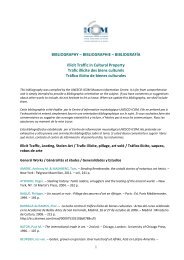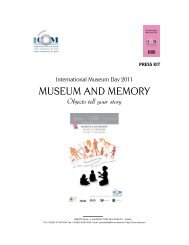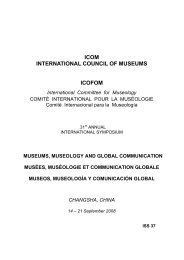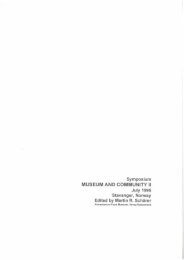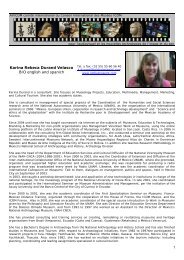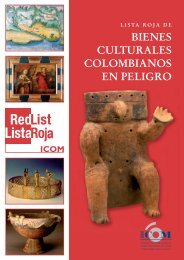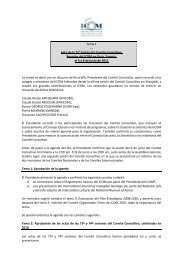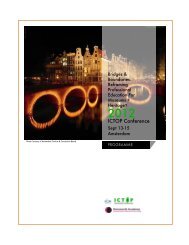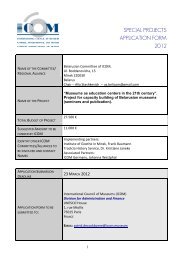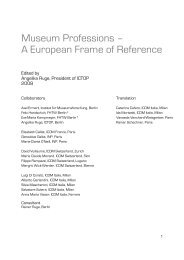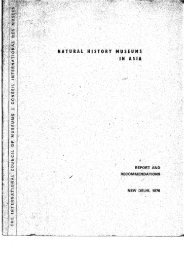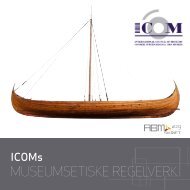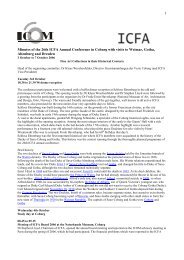Key Concepts of Museology - ICOM
Key Concepts of Museology - ICOM
Key Concepts of Museology - ICOM
Create successful ePaper yourself
Turn your PDF publications into a flip-book with our unique Google optimized e-Paper software.
HERITAGE<br />
n. – Equivalent in French: patrimoine; Spanish:<br />
patrimonio; German: Natur- und Kulturerbe;<br />
Italian: patrimonio; Portuguese: patrimônio.<br />
The notion <strong>of</strong> heritage (patrimonium)<br />
in Roman law referred to all the<br />
assets received by succession, assets<br />
which, according to law, are inherited<br />
by children from fathers and<br />
mothers; family assets, as opposed<br />
to assets acquired since marriage. By<br />
analogy, two metaphorical uses were<br />
born later. (1) Recently the expression<br />
‘genetic heritage’ to describe the<br />
here ditary features <strong>of</strong> a living being;<br />
(2) ear lier the concept <strong>of</strong> ‘cultural<br />
heritage’ seems to have appeared<br />
in the 17 th century (Leibniz, 1690)<br />
before being taken up again by<br />
the French Revolution (Puthod de<br />
Maisonrouge, 1790); Boissy d’Anglas,<br />
1794). The term, however, has<br />
many more or less broad meanings.<br />
Because <strong>of</strong> its etymology, the term<br />
and the notion that it infers have<br />
spread more widely in Romance<br />
languages since the 1930s (Desvallées,<br />
1995) than in the Anglo-Saxon<br />
world, which favoured the term property<br />
(goods) before adopting the<br />
term heritage in around the 1950s,<br />
while differentiating it from legacy.<br />
In the same way the Italian govern-<br />
H<br />
ment, while one <strong>of</strong> the fi rst to recognise<br />
the term patrimonio, continued<br />
to use the expression beni culturali<br />
(cultural goods). The idea <strong>of</strong> heritage<br />
is inevitably tied to that <strong>of</strong> potential<br />
loss or disappearance – as was the<br />
case after the French Revolution –<br />
and at the same time to the will to<br />
preserve these goods. “Heritage can<br />
be recognised by the fact that its loss<br />
means a sacrifi ce and that its conservation<br />
also presupposes sacrifi ces”<br />
(Babelon et Chastel, 1980).<br />
1. Starting with the French Revolution<br />
and throughout the 19 th century,<br />
heritage essentially referred to<br />
immovable property and was generally<br />
confused with the idea <strong>of</strong> historical<br />
monuments. A monument, in<br />
the original sense <strong>of</strong> the word, is a<br />
construction intended to perpetuate<br />
the memory <strong>of</strong> somebody or some<br />
thing. Aloÿs Riegl identifi ed three<br />
categories <strong>of</strong> monuments: those<br />
that were conceived intentionally<br />
“to commemorate a specifi c time or<br />
a complex event in the past” (intentional<br />
monuments), “those chosen<br />
by subjective preferences” (historical<br />
monuments), and fi nally “all the<br />
creations <strong>of</strong> mankind, independent<br />
<strong>of</strong> their signifi cance or their original<br />
intent” (ancient monuments)<br />
(Riegl, 1903). According to the prin-<br />
39



